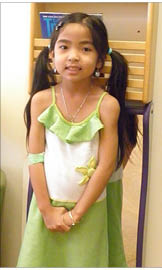Granulocyte Infusions Saved Little Katelyn
By Dr. Jennifer Andrews, Clinical Assistant Professor of Pathology (Transfusion Medicine) and Pediatrics (Hematology/Oncology)
When I first met Katelyn Do, she had already been diagnosed by my Pediatric Hematology colleagues with severe aplastic anemia. That means essentially that her bone marrow was no longer producing any blood cells, including white blood cells (in charge of fighting infections), red blood cells (in charge of carrying oxygen to all the organs in the body) and platelets (in charge of stopping any bleeding). Her doctors had started chemotherapy to help cure her of this disease, and those medications also decreased all of her blood counts. She was admitted to the hospital last fall for a very severe infection of her skin called an abscess. She was being treated with very strong antibiotics given by an IV but her infection was just not getting better. Her doctors consulted me in the Transfusion Medicine service at the hospital to start granulocyte (a type of white blood cell especially adept at fighting bacterial infections like abscesses) infusions to help her fight this infection. When physicians prescribe them, it means there really is no other treatment available. They are a last ditch effort’ to fight off infection.
Thanks to Stanford Blood Center staff and donors, I was able to arrange granulocyte collection for the next day. Special thanks go to the regular platelet donors. The staff at Stanford Blood Center was easily able to call three donors in their platelet donor program that had blood types compatible with Katelyn, and they were able to donate precious granulocytes for her.
Katelyn received granulocyte infusions for three days (one infusion per day), and her infection rapidly improved. She was able to go home from the hospital, and now eight months after I met her, she is doing very well on only one oral chemotherapy medicine that she is able to take every day at home. Some children with severe aplastic disease don’t respond to chemotherapy at all and need a bone marrow transplant, but Katelyn has responded very well and will not need a transplant. She is a very active little girl, and has returned to her normal activities and life as usual’ at home.
It’s because of the donors at Stanford Blood Center and treatment with chemotherapy by her doctors that Katelyn is still alive. Her infection was cured because of those granulocyte infusions. Also, during the course of her chemotherapy treatments, she has received both red blood cell and platelet transfusions to help her get better.
Blood donors, thank you so very much for donating life-saving products!

